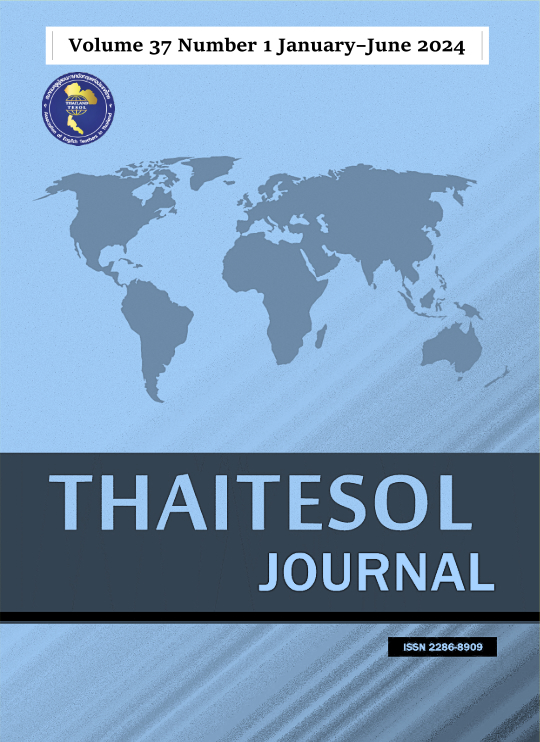Differences in Thai Students’ Anxiety When Speaking English in Onsite and Online Classrooms
Main Article Content
Abstract
Speaking English in a face-to-face classroom versus an online classroom may make EFL students feel uneasy in different ways, depending on a variety of factors. To help students reduce anxiety, teachers must understand the different levels of anxiety they experience in different situations. This study investigated the differences in English-speaking anxiety between face-to-face and an online classroom for Thai students, and used questionnaires and structured interviews to identify the factors that may contribute to the anxiety of different students. The questionnaire was completed by 26 first-year undergraduates from a Thai public university who had both face-to-face and online classroom experience in order to compare anxiety levels in the two learning environments. Seven students were then interviewed in order to determine the factors that may have contributed to these differences. The data from the questionnaire were presented as mean scores and standard deviation (SD) in order to compare the differences in students' anxiety between on-site and online classrooms, whereas the data from the interviews were used to explain the factors that could cause these differences. The results of the questionnaire revealed that, with the exception of confidence, students' speaking anxiety in face-to-face classrooms is greater in every respect than in online classrooms. In the meantime, the results of the interviews revealed that nervousness, a limited vocabulary, and an inability to remember vocabulary could be significant contributors to anxiety differences. The discussion explained how each aspect and factor makes speaking anxiety in on-site classrooms greater than in online classrooms, and suggested and encouraged teachers to reduce students' anxiety in both types of classrooms. Teachers can improve the language learning outcomes of their students by creating a less stressful environment in the English classroom and by incorporating activities that motivate or engage students to practice speaking.
Article Details

This work is licensed under a Creative Commons Attribution-NoDerivatives 4.0 International License.
Materials in THAITESOL JOURNAL may be photocopied for educational purposes. Under no circumstances may any part of this journal be photocopied for commercial purposes.
References
Abrar, M., Mukminin, A., Habibi, A., Asyrafi, F., Makmur, M., & Marzulina, L. (2018). “If our English isn’t a language, what is it?” Indonesian EFL student teachers’ challenges speaking English. The Qualitative Report, 23(1), 129–145. https://doi.org/10.46743/2160-3715/2018.3013
Ansari, M. S. (2015). Speaking anxiety in ESL/EFL classrooms: A holistic approach and practical study. International Journal of Education Investigation, 2(4), 38–46.
Boonmoh, A., & Kamsa-ard, T. (2023). Pre-service EFL Teachers' Anxiety regarding the Online Teaching Practicum during the COVID-19 Pandemic: Thailand Case Study. TESL-EJ, 27(1).
Daud, A., Ras, F., Novitri, N., & Audia, C. P. (2019). Factors contributing to speaking anxiety: A case study of pre-service English teachers. Journal of Educational Sciences, 3(3), 412–422.
Faqihi, M. A. H. (2023). Saudi EFL students' speaking anxiety from the perspective of their college instructors. International Journal of Education and Literacy Studies, 11(2), 138–146.
Hidayati, S., Oktaviani, L., & Aminatun, D. (2023). EFL students’ speaking anxiety: A case study at the first grade of Sma Al Huda Jati Agung. Journal of English Language Teaching and Learning, 4(1), 1–7.
Horwitz, E. K., Horwitz, M. B., & Cope, J. (1986). Foreign language classroom anxiety. The Modern Language Journal, 70(2), 125–132.
Huang, P., & Hwang, Y. (2013). An exploration of EFL learners' anxiety and e-learning environments. Journal of Language Teaching and Research, 4(1), 27.
Kaisar, M. T., & Chowdhury, S. Y. (2020). Foreign language virtual class room: Anxiety creator or healer? English Language Teaching, 13(11), 130–139.
Kalra, R., & Siribud, S. (2020). Public speaking anxiety in the Thai EFL context. LEARN Journal: Language Education and Acquisition Research Network, 13(1), 195–209.
Kurakan, P. (2021). Anxiety in English oral presentations of Thai EFL engineering students. THAITESOL Journal, 34(2), 67–92.
Leong, L. M., & Ahmadi, S. M. (2017). An analysis of factors influencing learners’ English speaking skill. International Journal of Research in English Education, 2(1), 34–41.
Mhuentoei, R. (2023). Public speaking anxiety of Thai undergraduates comparing online presentation and onsite presentation. The New English Teacher, 17(1), 1–28.
Mulyani, S. (2018). Investigating factors causing students’ anxiety in speaking English. International Journal in Applied Linguistics of Parahikma, 85–99.
Nugroho, I., Miftakh, F., & Wahyuna, Y. T. (2021). Exploring students’ speaking anxiety factors in an online EFL classroom. INTERACTION: Jurnal Pendidikan Bahasa, 8(2), 228–239.
Öztürk, G., & Gürbüz, N. (2014). Speaking anxiety among Turkish EFL learners: The case at a state university. Journal of language and Linguistic Studies, 10(1), 1–17.
Pruksaseat, C. (2022). Foreign language speaking anxiety of Thai EFL students in virtual classrooms-Pathumwan Institute for Technology students. Pasaa Paritat Journal, (37), 41–67.
Resnik, P., Dewaele, J. M., & Knechtelsdorfer, E. (2023). Differences in the intensity and the nature of foreign language anxiety in in‐person and online EFL classes during the pandemic: A mixed‐methods study. TESOL Quarterly, 57(2), 618–642.
Sadighi, F., & Dastpak, M. (2017). The sources of foreign language speaking anxiety of Iranian English language learners. International Journal of Education and Literacy Studies, 5(4), 111–115.
Sha'ar, M. Y. M. A., & Boonsuk, Y. (2021). What hinders English speaking in Thai EFL learners? Investigating factors that affect the development of their English speaking skills. Mextesol Journal, 45(3), 1–16.
Suryani, I., Suarnajaya, I. W., & Pratiwi, N. P. A. (2020). Investigating the inhibiting factors in speaking English faced by senior high school students in Singaraja. International Journal of Language Education, 4(1), 48–58.
Tsiplakides, I., & Keramida, A. (2009). Helping students overcome foreign language speaking anxiety in the English classroom: theoretical issues and practical recommendations. International Education Studies, 2(4), 39–44.
Valizadeh, M. (2021). Foreign language anxiety in virtual classrooms during the Covid-19 pandemic in Turkey. St. Theresa Journal of Humanities and Social Sciences, 7(1), 54–80.
Yaniafari, R. P., & Rihardini, A. A. (2021). Face-to-face or online speaking practice: A comparison of students’ foreign language classroom anxiety level. JEELS (Journal of English Education and Linguistics Studies), 8(1), 49–67.


